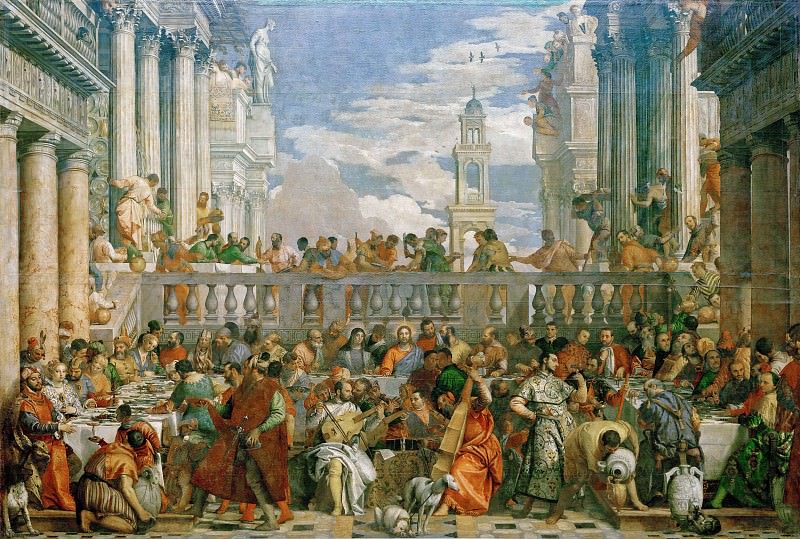The Feast at Cana Veronese (Paolo Cagliari) (1528-1588)
Veronese – The Feast at Cana
Edit attribution
Download full size: 4882×3288 px (3,6 Mb)
Painter: Veronese (Paolo Cagliari)
Album navigation:

On display in the Louvre is a painting gigantic in scale and astonishing in the magnitude of its creator’s gift, The Marriage at Cana in Galilee. The famous Venetian painter Paolo Veronese painted the canvas for a year. In 1563 he completed the grandiose work, which was placed in the refectory of the Catholic monastery, ordered by the monks of San Giorgio Maggiore. The painting depicts the Gospel scene of Christ’s first miracle: the transformation of water into wine, when it suddenly ended to everyone’s dismay.
Description of Paolo Veronese’s Marriage at Cana in Galilee
On display in the Louvre is a painting gigantic in scale and astonishing in the magnitude of its creator’s gift, The Marriage at Cana in Galilee. The famous Venetian painter Paolo Veronese painted the canvas for a year.
In 1563 he completed the grandiose work, which was placed in the refectory of the Catholic monastery, ordered by the monks of San Giorgio Maggiore.
The painting depicts the Gospel scene of Christ’s first miracle: the transformation of water into wine, when it suddenly ended to everyone’s dismay. It took place at a marriage celebration in the Galilean village of Cana.
A large, abundant table, with Jesus and His mother seated in the center, and several of the disciples beside them. Mary’s head is covered with a black kerchief as a symbol of the imminent mourning of Christ. Altogether about 130 people are seated on the canvas. Visually it is possible to divide their location on the picture into three zones.
In the foreground is a sumptuous feast with an island of musicians in the middle. No authentic portrait of the painter Veronese has survived, but legend has it that the man in white attire with the violet in his hands is a self-portrait of the author. The other musicians of the group were also artists in real life - the cornetist Bassano, Titian and the great Tintoretto completes the quartet. The groomsmen themselves, the bride and groom, are on the left side of the table at the edge.
The middle part of the painting is occupied by the bustling servants. Above Christ’s head is a symbolic action: the butcher raises his knife over the carcass of a lamb, a sign of future sacrifice.
The upper plane is occupied by ancient columns, which could not exist in the real Cana. From the white marble balconies curious onlookers watch the feast. In the distance the serene sky is shining, the clouds are floating about imposingly, and flocks of birds are hovering.
Veronese’s achievement is his masterly ability to harmoniously combine a religious subject with the luxurious costumes of his contemporaries and the atmosphere of the festivities of 16th century Venice.
Кому понравилось
Пожалуйста, подождите
На эту операцию может потребоваться несколько секунд.
Информация появится в новом окне,
если открытие новых окон не запрещено в настройках вашего браузера.
You need to login
Для работы с коллекциями – пожалуйста, войдите в аккаунт (open in new window).





You cannot comment Why?
Perhaps it’s a painting of a group of people on a balcony with a crowd.